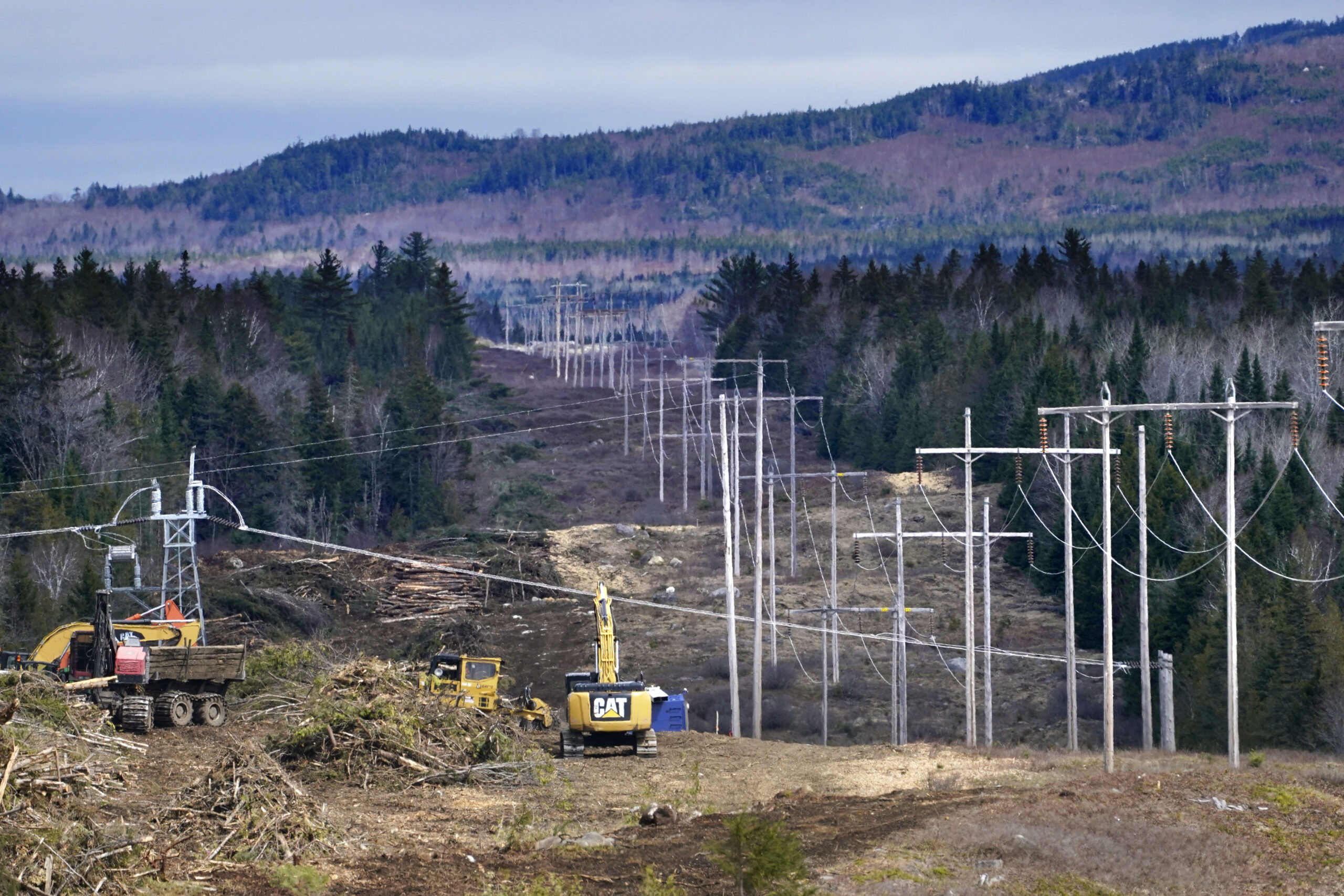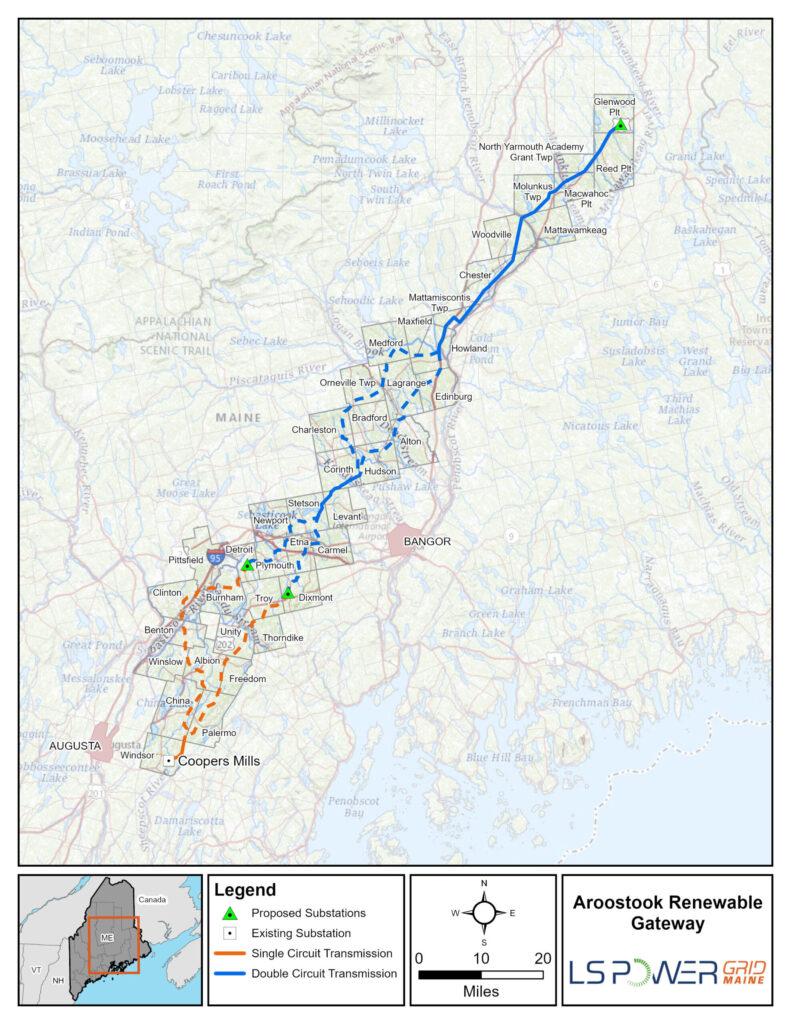
The proposed route of the Aroostook Renewable Gateway power line cuts diagonally through the middle of Daniel MacPhee’s organic farm.
And like many landowners along the LS Power route from southern Aroostook County to Coopers Mills, MacPhee is concerned about his farm’s future.
“I feel like they decided that farms are the path of least resistance. It’s open land already,” said MacPhee, who owns Blackbird Rise, an organic and native seed farm in Palermo near the end of the proposed transmission route.
In February, the Maine Public Utilities Commission selected New York-based LS Power and Long Road Energy’s King Pine Wind Project in Aroostook County for the gateway project. LS Power will build the transmission lines that connect to the New England grid and King Pine will generate the power.
The Maine Legislature approved LS Power’s transmission line but not the proposed route in late June. Gov. Janet Mills signed it into law.
But landowners and some lawmakers question how the law was passed without the proposed route, and want to know why LS Power is not following existing corridors that would keep the transmission lines off their land.
Every time he asked LS Power representatives about using existing corridors, they told him that those go over state lands and state lands were off the table, MacPhee said.

Parts of the proposed route run adjacent to existing corridors, but the company made adjustments because there were hundreds of homes in some areas and other obstacles, such as environmental constraints, tribal lands and state lands, said Doug Mulvey, an LS Power vice president.
Mulvey said LS Power avoided state lands because the company would need additional approval from the Legislature to use those parcels.
Under Maine law, developers must get two-thirds approval from the Legislature for transmission projects that cross state lands.
Prior to the June vote on the transmission line, Sen. Rick Bennett told the Legislature that he was concerned about voting without the route or the rates.
“The people of Maine have told us that they want our review of these projects and they want us to vote and make a decision,” he said. “There is this notion of ‘trust the PUC, trust the developers, we’ve got it covered.’ But the people of Maine have been burned in the past.”
Bennett shares their skepticism and asked that the Legislature come back for a special session to vote on the transmission line when more information, like the route, becomes available.
“They are trying to follow the path of least resistance, and when I say that, it is the path of least resistance politically, not having to go back to the Legislature to get a two-thirds vote,” said Steve Ingalls of Stetson. “It just doesn’t make sense why are they not using one of these other corridors? Why are they just plowing through organic farms?”
LS Power talked with more than 700 landowners during the recent information sessions regarding the proposed route and has fielded more than 400 phone calls and written correspondence from concerned landowners, Mulvey said.
“We gained a lot of information from landowners, and the route is not final,” he said. “It is subject to change.”
LS Power is required to receive community feedback so it can improve its proposal, Christine Kirby, communications director for Maine Senate President Troy Jackson’s office, said Friday.
“Legislative approval for the line in general was only one of the many approvals that LS Power will need to receive in order to build the line,” she said. “There will be continued oversight of any plans made by LS Power by both state and federal agencies.”
Jackson understands people’s concerns and does not support eminent domain in these circumstances, Kirby said.
If the route passes through someone’s land, LS Power will purchase easement rights but not the land, Mulvey said. It will work with appraisers to obtain the value of various types of land — wooded, cleared, farm and residential — and it will pay landowners at least fair market value for the easements, he said.
Ingalls, whose Stetson home is on a lake, said that if the proposed route is used, he will have to look at 150-foot transmission towers when he sits on his dock. There is a dip in the land across from him where the route will go up about an 80-foot ridge, which likely will be visible from many places in town, he said.
The transmission line passes through several of his neighbors’ properties, and they are concerned about wildfires, Ingalls said, referencing a recent Aroostook County fire started from a transmission line failure and California wildfires.
He pointed to a recent Vermont and New Hampshire project, the Twin States Clean Energy Link, between Canada and the United States as an example of an alternative approach.
The 211-mile, 1,200 megawatt transmission line will run through Vermont and New Hampshire using state highways for a new underground line that will come above ground when it reaches an existing utility corridor in New Hampshire, he said.
MacPhee, who has a little less than 75 acres, 50 of which are forested and the rest open fields, farms organic seed that he sells to seed companies and also native plant seed that he harvests for milkweed. Additionally, he and his neighbor farm several acres of vegetables.
MacPhee said it’s hard to quantify the impact this will have on his farm, which is on the eastern leg of the southern section of the route from Etna to Coopers Mills.
“Will people want to work with me under those lines or will I want to grow things under those lines?” he asked.
And the wide open corridor through his farm could attract snowmobilers and ATVers to drive over his perennial crops, plus provide a path for foraging deer, he said.
The people from LS Power were good at listening during the meetings, MacPhee said, but he has yet to see if they will act on what they heard.
“I hope that they did an honest first draft and want to get feedback,” he said.







